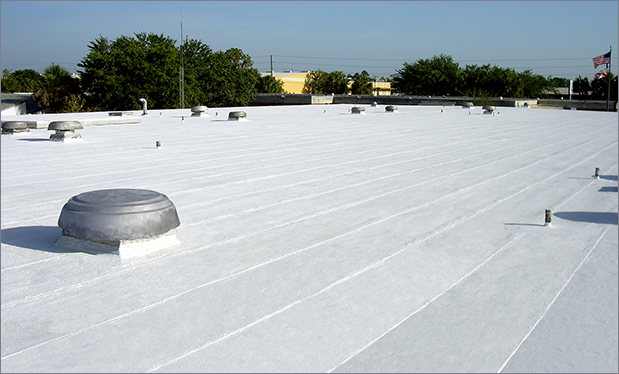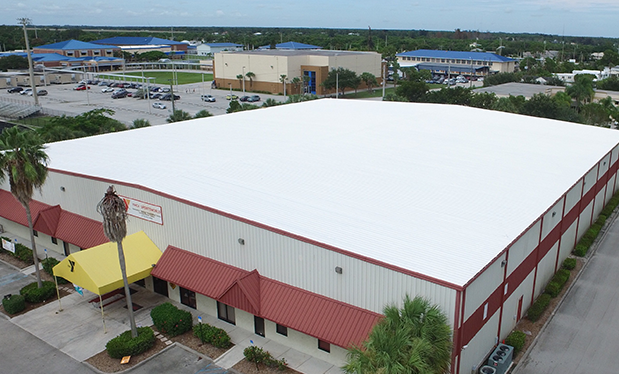Few roofing contractors, if any, get excited when customers are experiencing ice dams during the winter. It's often difficult to explain the many factors that contribute to ice dam formations. It's even more difficult to take immediate action to stop a leaking ice dam because steep-slope roof systems covered in snow often are not accessible. Unfortunately, for contractors in northern climates, modern construction practices are creating complex attic assemblies that are more likely to contribute to ice dam formations. Contractors need to carefully analyze all the issues to determine the root causes of ice dam formations, of which there could be many.
Definition
Describing the ice dam process does not need to be complicated; in fact, the definition is quite simple. Ice dams occur when the roof sheathing may have temperature differences from one roof section to another. Historically, roof sheathing at the eaves typically is colder than sheathing located over heated spaces. Ice dams do not occur every time it snows—they occur when a temperature differential of about 10 degrees Fahrenheit or more exists down the drainage plane of roof sheathing, enabling a thaw-freeze process to occur. Ice dams are most likely to occur when the outside ambient air temperature is 22 F or slightly colder.
Temperatures warmer than 22 F generally will not cool roof sheathing enough to cause melted snow to refreeze, according to Wayne Tobiasson's article, "Ventilating attics to minimize icings at eaves," published in 1994 and based on research conducted at Cold Regions Research and Engineering Laboratory. Also, when outside temperatures are significantly colder than 22 F, ice dams are less likely to occur because the roof sheathing usually is below freezing in all areas. It's important to note ambient attic air temperatures and roof sheathing temperatures will differ. For the sake of analyzing ice dam formations, focusing on the roof sheathing temperatures is more important. Infrared cameras and thermometers are excellent tools to measure roof sheathing surface temperatures.
In the absence of an infrared camera, analyzing snow-thaw patterns can be a great visual of roof sheathing temperature differentials. The photo depicts an unheated detached garage with snow on the roof and an inefficiently heated house. Snow on the heated house has melted because the roof sheathing temperature is obviously above freezing while the garage sheathing temperature is close to the ambient outdoor air temperature, allowing the snow to remain. Refreezing will not occur and cause an ice dam on any section of an unheated structure mainly because the roof sheathing temperatures will be consistent.
In the past, industry professionals have identified several causes for ice dam formations, including solar radiation, poor ventilation, inadequate insulation, air leakage and mechanical equipment in attic spaces. In reality, some of these items are contributing causes while others are essentially nonfactors. To address ice dams' root causes, instead of merely trying to repair a leak from a roof's surface, let's analyze these items individually to determine their effects on ice dams.
Solar radiation
Although many people believe sunlight, a form of solar radiation, contributes to ice dam formations, it doesn't. Proof by contradiction can be used to show why sunlight is not responsible for ice dam formations. Making the assumption solar radiation causes ice dams, you should expect that nearly every roof system exposed to sunlight would form an ice dam, including unheated buildings. You also would expect ice dams to not occur on cloudy days or at nighttime. Experience tells us this assumption is false because all roofs exposed to sunlight do not form ice dams, unheated buildings never form ice dams, and ice dams actually are more likely to form on cloudy days and at nighttime.
When temperatures are below freezing, rooftop snow can melt from two heat sources—solar radiation and warm roof sheathing. Solar radiation melts snow from the top layer down while the roof sheathing melts the bottom layer of snow. The layer of melting snow directly exposed to sunlight reaches higher temperatures than the bottom layer of melted snow at the roof sheathing's surface. Melting snow in contact with the roof sheathing is insulated from solar radiation by the layers of snow above it. Ice dams occur in a small range of temperatures slightly higher than 10 F, and water exposed to solar radiation is not cold enough to be within this range. However, snow melted from contact with the roof sheathing and not exposed to sunlight is likely to refreeze when sheathing surface temperatures return to 22 F or below.
Snow insulates roof sheathing from solar radiation, making sheathing temperature differentials occur from only interior heat sources. When roof coverings are exposed in some areas but not all areas, the surface temperatures of the sheathing rise quickly. Solar radiation can cause roof sheathing temperature differentials in some instances, but temperatures will not decrease within the required ranges to cause ice dams. The temperature of roofing materials not covered in snow on a 22 F day can reach 65 F depending on the roof covering. The roof sheathing in the attic space is warmed well above freezing by radiation and conduction. The warmth from the sunlight quickly causes attic temperatures to rise so high a freeze-thaw scenario will not occur.
Poor ventilation
Poor ventilation in itself is not a cause of ice dam formations, and natural (passive) methods of ventilation, such as intake and exhaust vents, will not prevent them. In fact, a building with an efficient thermal boundary, regardless of ventilation, is not a typical candidate to form an ice dam. Unventilated attic assemblies can be constructed to be free from ice dams as long as insulation levels are great enough to maintain consistent sheathing temperatures and air leaks are eliminated.
Adequately ventilating an attic space does not guarantee roof sheathing temperatures will remain consistent. Ventilation will reduce ambient attic air temperatures but is less effective at reducing roof sheathing temperatures. According to Building Science Corp., Westford, Mass., proper passive ventilation systems can reduce the temperature of the roof sheathing between a few degrees to no more than 10 degrees than a poorly ventilated attic space. The color of the roofing materials and the sun's orientation have greater effects on the roof sheathing temperature than the amount of passive ventilation. Thermal inefficiencies, including heat sources, in attic spaces are the only root causes for ice dams and when they are eliminated, ice dams will be prevented from forming.
Power vents can protect against, and in some situations eliminate, ice dam formations but are not efficient for eliminating their root causes. Mechanical ventilation, typically far in excess of minimum building code requirements, can uniformly cool roof sheathing temperatures to a level below freezing and eliminate the risk of ice dam formations. However, a more efficient approach is to eliminate the heat source in the attic, eliminating the need for mechanical ventilation.
Inadequate insulation
The most common causes for ice dam formations result from inefficiencies in a heated structure's thermal boundary. Inadequate levels of insulation, displaced insulation and air leakage are examples of these inefficiencies. Continuous levels of insulation installed according to the Department of Energy's recommendations will prevent ice dams from occurring as long as heat sources are not present in the attic space. Ice dams and their resulting leaks usually can be corrected with improvements to the thermal boundary alone.
Inadequate levels of insulation allow heat to escape from conditioned living spaces and warm the roof sheathing. For example, an ice dam that has a history of occurring on a house in Climate Zone 5 with an attic insulation level of R-19 can be prevented by increasing the level of insulation to R-49. This improvement to the thermal boundary will prevent heat loss and ensure the roof sheathing temperature is below freezing when it is covered in snow. Low insulation levels are relatively easy to fix, but ice dam remediation often is not this simple.
Air leakage
When snow covers a roof system, it insulates the attic space and prevents heat from escaping. An inch of snow has an R-value of about 1. This means 12 inches of snow have nearly the same amount of thermal resistance as wall insulation and can cause ambient air and roof sheathing temperatures in attic spaces to rise. Building occupants and homeowners have a tendency to crank up the furnace during cold winter days as well, and air leakage becomes problematic.
Ductwork is a source of heat within an attic space and any air leakage that occurs from ductwork located above the thermal boundary can cause ice dams. Even ductwork installed efficiently typically is insulated to no more than R-6, radiating heat up to 50 F into an attic space. If leaking, it can exhaust air into an attic at temperatures as high as 80 F. Although not always possible, ductwork located within the thermal building envelope reduces the risk of ice dam formation and increases the thermal performance of mechanical equipment.
Mechanical contractors, design professionals and property owners often are unaware of the burden redirected to roofing contractors when these inefficient systems are installed. If the decisions about mechanical equipment locations were based solely upon roofing considerations, it would be more desirable to place ductwork within the thermal envelope instead of above it.
Mechanical equipment
A relatively new trend in construction is to locate mechanical equipment, such as furnaces, in attic spaces of steep-slope structures. This can be disastrous for roofing contractors in northern climates. Furnaces can give off tremendous amounts of heat and create temperature differentials in a roof sheathing. Many complex attic assemblies, especially those in multifamily properties, are constructed with firewalls or other types of framing that contain the heat from spreading to other areas. The result often is ice dam formations in places contractors historically are not used to seeing and that are extremely difficult to fix.
Most roofing manufacturers and building codes in northern climates require ice and water underlayment to project 24 inches inside the interior walls at the eaves. Depending on the locations of the furnaces and the complexity of attic spaces, ice dams can form well inside the 24-inch area at the eaves that is protected by ice and water underlayment. When a leak occurs from this furnace configuration type, it is no easy task for contractors to explain the cause to property owners nor is it an easy task to correct the problem. HVAC professionals are not likely to provide solutions, and roofing contractors have limited prevention or repair options.
Ventilation codes were drafted in the 1940s, long before the widespread practice of installing furnaces in attic spaces. When a vapor retarder is not present, many building codes and shingle manufacturers require the 1:150 ventilation ratio of 1 square foot of net free vent area per 150 square feet of attic floor space. Unfortunately, when ductwork and mechanical equipment are located within the attic space, ventilation codes are insufficient. In reality, natural ventilation will not cool the roof sheathing near the furnace more than a few degrees Fahrenheit. Mechanical roof ventilation could provide a solution but often is impractical because it would require industrial-type ventilators to be effective.
Other design criteria not addressed can increase the severity of ice dam formations. These items include low roof slopes, poor drainage, large tributary areas, length of eaves, gutter sizes and lengths, and downspout placement.
A complex issue
Historically, ice dam remediation has been focused on issues surrounding thermal inefficiencies, but as attic spaces are constructed in a more complex manner, ice dam formations are more likely to occur. Unfortunately, building codes and manufacturer recommendations do not consider the unintended consequences of placing furnaces, other mechanical equipment and ductwork in attic spaces. Ventilation codes and underlayment specifications are ineffective in their current forms, and ice dam formations no longer are confined to the eaves.
To further complicate the matter, the architectural community and HVAC contractors are relatively unaware of the problems associated with their design and installation practices, leaving roofing contractors to correct the associated problems. These problems are costly to correct, outside the scope of typical roofing operations and can be difficult to pinpoint. The relocation of mechanical equipment usually is not an option, either.
Ice dams can be prevented when insulation is properly installed, air leakage does not exist and all sources of heat are located within the thermal boundary. Inspecting an attic space for heat sources and inefficiencies before new roof system installations can enable a roofing contractor to predict the likelihood of an ice dam formation. If the possibility is great enough, contract provisions can be added to your proposal to limit your liability when the snow begins to fall.
Nick Sabino is president of Deer Park Roofing Inc., Cincinnati.
For an article related to this topic, see "The ice dam cometh," November 2015 issue.



